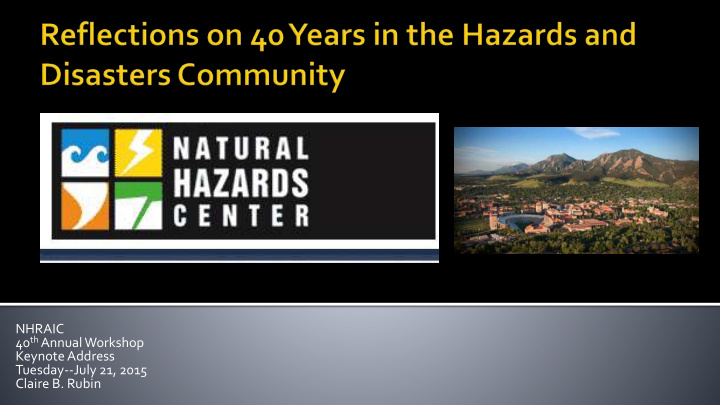



NHRAIC 40 th Annual Workshop Keynote Address Tuesday--July 21, 2015 Claire B. Rubin
I have had a quite varied career path: Researcher Consultant Practitioner Educator Lot of part-time and consulting assignments Attended 38 out of40 Workshops! 2
Government Academia Federal Disaster Assistance Administration American University U.S. Environmental Protection Agency Georgetown University Federal Emergency Management Agency George Washington University FEMA Region IX University of Maryland University College Arlington County, VA For Profit Non-Profit Triway International Group Academy of State/Local Government Emergency Management Magazine World Bank Loch Haven Partners Natural Hazard Mitigation Association Ian McLean Consultancy, Rotorua, NZ Oak Ridge National Lab (CARRI project) Roy F. Weston Public Entity Risk Institute ICF Consulting Homeland Security Studies and Analysis SRA International Institute Marasco-Newton Natural Hazards Mitigation Association It can be a juggling act ICMA- Int’l City/County Management Assoc. sometimes... 3
Gilbert White, Center Director YMCA Camp, Estes Park , CO Attendees: • Roy Popkin • Ugo Morelli • About 70-80 others 4
The pantheon of capable, dedicated members of the hazards research and Emergency Management communities and the many people who provided inspiration and guidance to me through the years, starting with: 5
The NGA was engaged in some essential research and produced several ground-breaking, baseline documents on emergency management. Volume on Comprehensive Emergency Management (1978) Baseline for the newly-formed FEMA 6
In the late 1990s to early 2000s: affiliation with GWU led to my developing teaching products and educational materials. A key feature of the time line charts is how reactive our national system of emergency management is.
Natural Hazard Research and Applications Information Center (CO) FEMA’s Emergency Management Institute (MD) Disaster Research Center (DE) 8
Hazards Center: many of the major researchers who create the intellectual content FEMA/EMI: Primarily deliverers of education and training (based in Washington DC) The Natural Hazards Center has filled the role of a professional association: – it offers an annual workshop, has a newsletter or two, and supports a community of people with common interests. 9
Plans for the history book began in 2004. To document the history of emergency management in the U.S. We had documented the outline of recent decades of history in the disaster time line charts. The book is now in its second edition 10
Being based in Washington, DC was essential to my career in that I got in on some foundational projects, which were essential to capturing history, since so much of the Emergency Management history was never formally written down. FEMA; NSF; EPA; DHS 11
During this time period we saw the build-up of the Emergency Management field: - in terms of personnel numbers - development of plans, policies, and tools - higher education programs - increasing professionalization (excluding this cartoon) 12
Loma Prieta Earthquake (1989) Hurricane Hugo (1989) Exxon Valdez (1989) Hurricane Andrew (1992) Great Midwest Floods (1993) Northridge Earthquake (1994) 13
Work of the NGA and creation of Comprehensive EM (1978) FEMA formed by Executive Order, 6/19/1978 Development of the draft Federal Response to a Catastrophic EQ Plan (the precursor to what is now the National Response Framework (late 80s) The first ICMA green book on EM ( 1991) – start of the higher education emphasis (1998) Community Recovery After a Major Disaster (1985), published by NHRAIC Public Entity Risk Institute created (1997) with private endowment. They were risk takers, funded small projects, exerted their independence in support of worthwhile projects. 14
It was the first in-depth evaluation of FEMA, done 12 years into its operation and about half way through its roughly 25 years as an independent agency. It was influential, especially to J.L. Witt, who assumed his position as FEMA Director just as the report was being finished. It remained relevant for many years and was frequently cited. 15
Hurricanes Katrina, Rita and Wilma (2005) 9/11 (2001) BP Oil Spill (2010) Mega Storm Sandy (2012) International Earthquakes (Haiti, Japan, Nepal) 16
Events of 9/11 : 2003 formation of DHS (office of HS came first) and the Terrorism Time Line Chart (www.disaster-timeline.com) outlines the major legislation and public policy outcomes from 2001-2008. Hurricane Sandy : first use of the National Disaster Recovery Framework (issued in 2011) for a major disaster event 17
Some Observations: Research Community Federal Agency and Congressional Actions Emergency Management Training and Education Hazards/Disaster Science and Public Policy 18
Emergency Management has become an ever changing field with new threats and hazards, and more complex meanwhile the population is growing and moving to the most vulnerable geographic areas. Events are covering ever wider areas and needing billions of dollars for recovery. Hence, there is an even greater need for frequent updates in enabling legislation, guidance, programs, and education and training. 19
Growth in knowledge does not necessarily result in growth in competence and effectiveness. Recovery as example of limited progress: There has been relatively little progress on long-term recovery — the longest and most expensive phase of EM. Susan L. Cutter (University of South Carolina) 20
Like all endeavors, progress in our field has not been a straight line. There are many lurches forward and backward. “Punctuated equilibrium” is the term public administration researchers have used. In the coming years, we face new threats/hazards, along with advances in technology and science. We will have a vastly wider range of choices and tools, but also a comparably large number of risks and responsibilities. Are we up to the challenge? 21
Claire B. Rubin www.clairerubin.com www.disaster-timeline.com http://recoverydiva.com www.disastersandfaith.com cbrubin@gmail.com 22
Recommend
More recommend